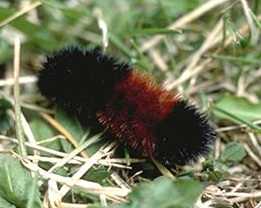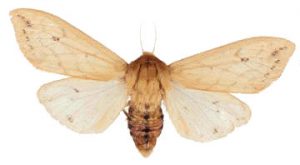Wooly Bear Caterpillars

The Wooly Bear turns into a Isia Isabella moth.

The banded woolly bear larva emerges from the egg in the fall and overwinters in its caterpillar form. It survives winter freezes by producing a cryptoprotant in its tissues. Once the weather warms, the larva devours all the grass and weeds it can, pupates, and becomes an adult, which then lives through the summer.
Larvae produced in the same clutch of eggs can vary from mostly red to mostly black, even when reared under the same conditions. The orange band will grow towards the ends of the body, with the black bands decreasing in size, as the larva matures.
They believe that if a wooly bear caterpillar’s brown stripe is thick, the winter weather will be mild and if the brown stripes are narrow, the winter will be severe.
One experiment showed that the color bands might tell where the caterpillar grew up. Some think that the wide black bands mean the caterpillar was living in wet conditions while the wide brown band means the caterpillar was living in dry conditions.
The coloration may also show how near being an adult the caterpillar is. At full growth, fall weather signals the wooly caterpillar to seek shelter, as ladybugs do.
In the late 1600s, farmers relied on weather history to predict weather. For that reason, they looked for something in nature to help them. They found the wooly bear caterpillar. Reports about the weather, along with a comparison of wooly bear stripes, made people think that the wooly bear’s coat was a good signal about weather. Some people still believe the wooly bear caterpillar can be used to predict weather.
